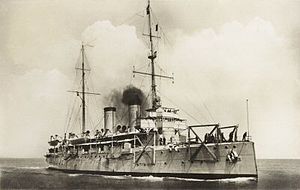HNLMS Gelderland (1898)

Gelderland
|
|
| History | |
|---|---|
|
|
|
| Name: | Gelderland |
| Builder: | Fijenoord, Rotterdam |
| Laid down: | 1 November 1897 |
| Launched: | 28 September 1898 |
| Commissioned: | 15 July 1900 |
| Fate: |
Seized by Germany, 1940 |
|
|
|
| Name: | Niobe |
| Commissioned: | 1 March 1940 |
| Fate: | Sunk by enemy action on 16 July 1944 |
| General characteristics | |
| Class and type: | Holland-class cruiser |
| Displacement: | 4,100 t |
| Length: | 94.76 m (310.9 ft) |
| Beam: | 14.76 m (48.4 ft) |
| Draught: | 5.4 m (18 ft) |
| Propulsion: |
|
| Speed: |
|
| Complement: | 397 |
| Sensors and processing systems: |
|
| Armament: |
|
Seized by Germany, 1940
HNLMS Gelderland (Dutch: Hr.Ms. Gelderland) was a Holland-class cruiser of the Royal Netherlands Navy. During its career in the Dutch Navy it was most notable for being the ship Queen Wilhelmina sent to South Africa to rescue Paul Kruger during the Second Boer War. The ship was taken over by the Germans during World War II and renamed Niobe. She was sunk in Kotka harbour in Finland on 16 July 1944.
The ship was built at the Maatschappij voor Scheeps- en Werktuigbouw Fijenoord in Rotterdam and launched on 28 September 1898. The ship was commissioned on 15 July 1900. On 22 November that year she arrived in Marseille with Paul Kruger who she had picked up in Lourenço Marques by order of the Dutch Government. After dropping Kruger off she left for the Dutch East Indies. During this trip while entering the harbor of Port Said she collided with the British steamer Peterson. The collision required the ship to be repaired at Suez. On 6 January 1901 she could resume her journey and arrived three days later on 9 January in Surabaya.
On 6 July 1904 Gelderland and Utrecht both ran aground near Aroes Lampoejang, South Sumatra because of incomplete maps. The ships were repaired in Surabaya and Singapore respectively.
On 17 June 1905 Gelderland and her sisters Noordbrabant and Utrecht returned to the Netherlands. The journey involved stops in Tanjung Priok Mahé, Perim, Port Said, Algiers and Tangier arriving at Den Helder on 30 August that year.
...
Wikipedia
